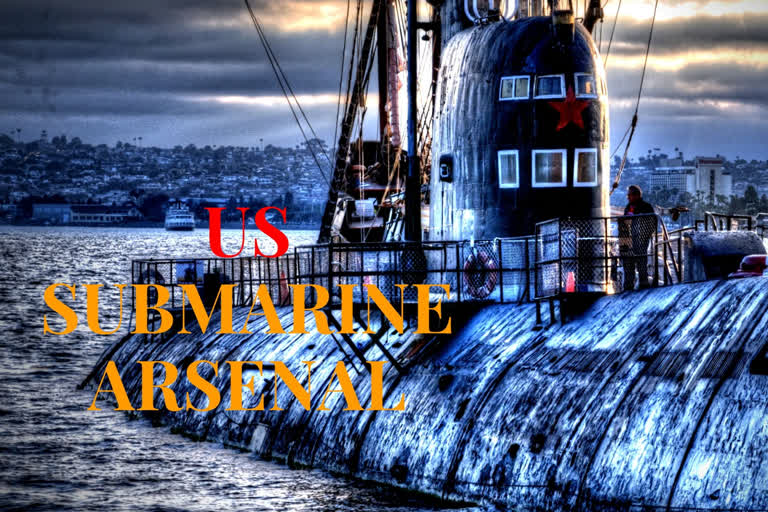Washington: The US military has deployed a new addition to its nuclear arsenal a long-range missile armed with a nuclear warhead of reduced destructive power. The so-called low-yield missile joins other, more powerful weapons aboard stealthy submarines prowling the oceans.
The debut deployment aboard long-range submarines, known as boomers, is a landmark in US nuclear weapons policy. It is the first major addition to the strategic nuclear arsenal in recent decades and is a departure from the Obama administration's policy of lessening dependence on nuclear weapons in pursuit of a nuclear-free world.
In confirming the missile deployment, the Pentagon's top policy official asserted that the weapon makes Americans safer by making nuclear war less likely. Critics, including some Democrats in Congress, call it a dangerous excess that increases the risk of war.
John Rood, the undersecretary of defense for policy, said in an interview Monday that adding the low-yield warhead, known as the W76-2, to submarines which tote Trident II ballistic missiles lowers the risk of nuclear war.
Read more: Senate wraps up questions for impeachment trial
He said the United States will continue its stated policy of using nuclear weapons only in extraordinary circumstances. He also said the warhead will help the United States dissuade Russia from risking launching a limited nuclear conflict.
This supplemental capability strengthens deterrence and provides the United States a prompt, more survivable low-yield strategic weapon, Rood said, adding that it supports the US commitment to deter attacks against allies, and demonstrates to potential adversaries that there is no advantage to limited nuclear employment because the United States can credibly and decisively respond to any threat scenario.
Rood declined to provide details about the deployment, including when or where the deployment began; all details, he said, are classified secret. The deployment was reported last week by the Federation of American Scientists, citing anonymous sources and reporting that it was believed to have begun in the final weeks of 2019 with an Atlantic deployment of the USS Tennessee.
Adding the W76-2 fits President Donald Trump's stated interest in beefing up the nuclear arsenal, although he has not commented on this specific weapon. His administration is committed to a broader, costly modernization of the nuclear force.
The essence of critics' argument against the low-yield weapon is that it makes the world less safe because it offers decision-makers another option for using a nuclear weapon in a conflict that could then escalate to a full-blown nuclear war. They also contend that lower-yield air-launched nuclear weapons already in the US arsenal make the W76-2 redundant.
Rood, however, said the submarine-launched low-yield missile is important because it can more reliably penetrate air defenses than could an airplane armed with nuclear weapons. The W76-2 is the Trump administration's answer to what it calls a Russian misconception of an exploitable gap in US nuclear capabilities.
By deploying missiles at sea with a lower nuclear yield, or destructive power, the administration aims to dissuade Moscow from thinking it could win a war in Europe, for example, by firing its own low-yield nuclear weapon first, forcing Washington and its NATO allies to either commit to full-scale nuclear war or capitulate.
Also read: US Senate reject mid-trial effort to call witness, documents
The yield, or destructive power, of the W76-2, is classified. Experts say it may be about 5 kilotons, or roughly one-third the destructive power of the Little Boy nuclear bomb the United States dropped on Hiroshima, Japan, in the final days of World War II, killing tens of thousands of people.
By comparison, the missile that has been deploying aboard strategic submarines for decades has carried the 90-kiloton W76 warhead and the 475-kiloton W88 warhead. The newly deployed warhead was produced by modifying the W76. Last February the administration said it expected to have the new version ready for use by late 2019.
The W76-2 has been fitted atop an undisclosed number of Trident ballistic missiles carried aboard the Navy's Ohio-class submarines. This submarine fleet, split between bases at Bangor, Washington, and King's Bay, Georgia, represents one leg of the US nuclear triad, along with the Air Force's long-range B-2 and B-52 bombers and land-based Minuteman 3 missiles.
The newest addition to the arsenal comes amid important shifts in the US-Russia strategic relationship. Doubts are growing that the Trump administration will accept Moscow's offer to extend the New START arms control treaty before it expires next February.
It is the only remaining treaty limiting the number of US and Russian strategic nuclear weapons. Rood noted that deploying the new lower-yield missiles has not increased the total number of American weapons under the New START limits because each of the warheads replaces one of the more powerful versions that had been exclusively deployed aboard the subs.
Bruce Blair, a former Air Force nuclear weapons officer and co-founder of Global Zero, an international group that advocates the elimination of nuclear arms, said he sees merit in reducing the destructive power of nuclear arsenals.
Also read: Democrats demand Bolton testify at Trump's impeachment trial



